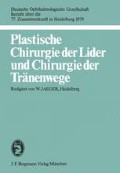Zusammenfassung
Bei jedem Kind, das wegen einer Amblyopie behandelt wurde, muß eine Nachsorge bis zum zwölften, besser bis zum 15. Lebensjahr erfolgen. Diese Forderung wurde auf dem Rundtisch-Gespräch vor dieser Gesellschaft in Hamburg 1972 erhoben (Holland). Aufgrund eigener Ergebnisse müssen wir sagen, daß mit hoher Wahrscheinlichkeit nach Beendigung einer Okklusions-Behandlung eine Zunahme der Amblyopie erfolgt. Zwar sinkt die Sehschärfe des geführten Auges nur gering, die des führenden nimmt aber zu, so daß der Unterschied größer wird. Der Visus-Unterschied zwischen beiden Augen ist das Maß für die Amblyopie, wir bezeichnen ihn als Amblyopie-Faktor. Dieser ist der Quotientaus der Sehschärfe des besseren und der des schlechteren Auges.
Access this chapter
Tax calculation will be finalised at checkout
Purchases are for personal use only
Preview
Unable to display preview. Download preview PDF.
Literatur
Bernsmeier, H., Friedburg D.: Das Auflösungsvermögen Amblyoper. Ber. Dtsch. Ophthalmol. Ges. 77, 345–347 (1980).
Campbell, F.W., Hess, R.F., Watson, P.G., Banks, R.: Preliminary results of a physiologically based treatment of amblyopia. Br. J. Ophthalmol. 62, 748–755 (1978).
Eccles, J.C.: Das Gehirn des Menschen. München: Piper 1976, S. 219ff.
Gstalder, R.J., Green, D.G.: Laser interferometric acuity in amblyopia. J. Pedriatr. Ophthalmol. 8, 251–256 (1971).
Holland, G. (Gesprächsleiter): Round-Table-Gespräch Amblyopiebehandlung. Ber. Dtsch. Ophthalmol. Ges. 72, 420–43 (1974).
Imbert, M.: Developmental plasticity in the visual cortex. In: Berenburg, S., Brain. Fetal and infant, (ed.): The Hague: Nijhoff 1977.
Imbert, M., Buisseret, P.: Receptive field characteristics and plastic properties of visual cortical cells in kittens reared with or without visual experience. Exp. Brain Res. 22, 25–36 (1975).
Peck, C.K., Blakemore, C.: Modification of single neurons in kitten’s visual cortex after brief periods of monocular experience. Exp. Brain Res. 22, 57–68 (1975)
Author information
Authors and Affiliations
Editor information
Editors and Affiliations
Rights and permissions
Copyright information
© 1980 J.F. Bergmann Verlag
About this paper
Cite this paper
Friedburg, D., Bernsmeier, H. (1980). Amblyopie-Nachsorge mit Fernseh-Okklusion. In: Jaeger, W. (eds) Plastische Chirurgie der Lider und Chirurgie der Tränenwege. Deutsche Ophthalmologische Gesellschaft, vol 77. J.F. Bergmann-Verlag, Munich. https://doi.org/10.1007/978-3-642-87882-4_159
Download citation
DOI: https://doi.org/10.1007/978-3-642-87882-4_159
Publisher Name: J.F. Bergmann-Verlag, Munich
Print ISBN: 978-3-8070-0321-4
Online ISBN: 978-3-642-87882-4
eBook Packages: Springer Book Archive

